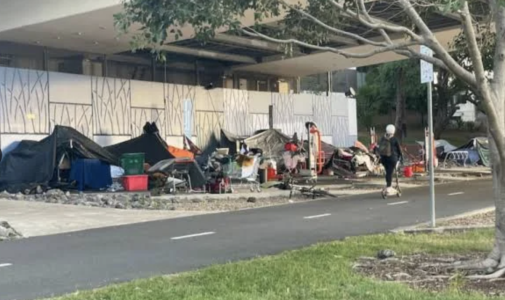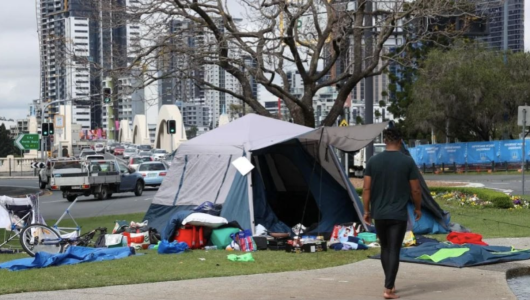Viral photo reveals city's descent from paradise to crisis: 'This is so sad to witness'
By
Seia Ibanez
- Replies 22
Brisbane, once a beacon of laid-back living and affordable housing, is now a city in the throes of a housing and homelessness crisis that has shocked the nation.
A viral image on social media has laid bare the stark reality: tent cities are emerging across the city, from parks to footpaths, beneath bridges, and along busy roads.
The photo that sparked widespread concern shows a man's makeshift camp beside the bustling William Jolly Bridge—a poignant symbol of a city grappling with a deepening social issue.
The image, shared on social media, has become a rallying cry for action as it highlights the growing visibility of homelessness in Brisbane.

‘This is so sad to witness, and it’s increasing,’ they wrote.
One shared their observation about the crisis in the city, saying, ‘She is a barmaid and gets 24 hours a week. It is not enough to pay rent after food, clothes and paying off a past debt. She had a room with other women in a two-bedroom house but the landlord has put the rent up to $650 a week and none of them could afford a place.’
The housing market in Brisbane has undergone a seismic shift. Not long ago, it was a haven for those fleeing the exorbitant prices of Sydney and Melbourne, offering more bang for their housing buck.
Today, the median house price in Brisbane stands at a staggering $970,000, surpassing Melbourne by nearly $70,000.
In the past year alone, home values in Brisbane have surged by 12.5 per cent, a rate that far exceeds the national average of 5.71 per cent.
This crisis isn't confined to homeowners. The rental market has also been hit hard, with average weekly rents for houses reaching $724 and units at $577.
These prices have been climbing at a rate of about 10 per cent per year for the past three years, a trend that has left many struggling to keep a roof over their heads.
The Rental Affordability Snapshot by Anglicare Australia painted a grim picture: essential workers, including teachers, nurses, and aged care staff, are finding it increasingly difficult to live affordably.
The report revealed that a mere fraction of rentals are within reach for these vital community members, with 3.7 per cent of rentals deemed affordable for teachers and even fewer for other essential professions.
The social implications of this crisis are profound.
The Queensland Council of Social Services reported that individuals in dire need of housing assistance languish on social housing registers for an average of two and a half years.
‘This data highlights what our services are telling us on the ground,’ QCOSS Chief Executive Aimee McVeigh said.
‘More and more families with children are struggling to make ends meet and paying the rent has become an expense people cannot afford.’
‘Sadly, this has become the norm for more and more families.’
‘We are now seeing a generation of children growing up in poverty through no fault of their parents. They simply cannot afford to pay for necessities such as food, electricity, fuel and rent.’
The emotional toll of this crisis is equally devastating.
Act for Kids CEO Katrina Lines has highlighted the strain on families.
‘The cost-of-living crisis has caused prolonged strain on families, not just financially, but emotionally,’ Dr Lines said.
‘Frontline services like ours are seeing this stress manifest in violence and abuse in the home, which vulnerable young children are being exposed to.’
‘If experienced over time, there may be lifelong impacts for children, including substance and mental health issues, suicidal ideation, difficulties in forming and maintaining healthy relationships, unemployment, and various social disadvantages.’
‘The emotional cost of this crisis will be felt by Queenslanders for years to come.
Yet, experts argue that this crisis is entirely preventable. Professor Cameron Parsell from The University of Queensland's School of Social Science contends that homelessness is a direct result of policy choices.
‘People are homeless not because the country lacks the wealth to do better, nor because we don’t know how to end it,’ he wrote.
‘We know homelessness is the result of how we choose to organise society. This includes the choices we make about housing affordability, the extent, resourcing and accessibility of public health and human services, and the quality of connections between housing and the services and resources people need to live meaningful lives.’
The data supports this claim, showing that the cost of government services for chronically homeless individuals drops significantly when they are provided with supportive housing.
Brisbane's population boom has exacerbated the housing crisis.
The city has seen its population swell by tens of thousands in recent years, with many newcomers initially relying on the rental market.
According to Professor Hal Pawson, a researcher at UNSW Sydney and Associate Director of the City Futures Research Centre, Queensland is ‘at the centre of a housing storm’.
He said the major drivers of this crisis ‘have been building for decades’ despite being a big part of the problem was the COVID-induced price increase and rental supply shortage.
‘Perhaps the most important of these have been the ongoing fall in homeownership rates, especially among younger adults, and our increasingly inadequate social housing system,’ he added.

Have you or someone you know been affected by the housing crisis? What solutions do you think could help alleviate this growing problem? Let us know in the comments below.
A viral image on social media has laid bare the stark reality: tent cities are emerging across the city, from parks to footpaths, beneath bridges, and along busy roads.
The photo that sparked widespread concern shows a man's makeshift camp beside the bustling William Jolly Bridge—a poignant symbol of a city grappling with a deepening social issue.
The image, shared on social media, has become a rallying cry for action as it highlights the growing visibility of homelessness in Brisbane.

A viral photo showed the current situation in Brisbane, which used to be a city paradise. Credit: u/InnerBalanceSeekr / Reddit
‘This is so sad to witness, and it’s increasing,’ they wrote.
One shared their observation about the crisis in the city, saying, ‘She is a barmaid and gets 24 hours a week. It is not enough to pay rent after food, clothes and paying off a past debt. She had a room with other women in a two-bedroom house but the landlord has put the rent up to $650 a week and none of them could afford a place.’
The housing market in Brisbane has undergone a seismic shift. Not long ago, it was a haven for those fleeing the exorbitant prices of Sydney and Melbourne, offering more bang for their housing buck.
Today, the median house price in Brisbane stands at a staggering $970,000, surpassing Melbourne by nearly $70,000.
In the past year alone, home values in Brisbane have surged by 12.5 per cent, a rate that far exceeds the national average of 5.71 per cent.
This crisis isn't confined to homeowners. The rental market has also been hit hard, with average weekly rents for houses reaching $724 and units at $577.
These prices have been climbing at a rate of about 10 per cent per year for the past three years, a trend that has left many struggling to keep a roof over their heads.
The Rental Affordability Snapshot by Anglicare Australia painted a grim picture: essential workers, including teachers, nurses, and aged care staff, are finding it increasingly difficult to live affordably.
The report revealed that a mere fraction of rentals are within reach for these vital community members, with 3.7 per cent of rentals deemed affordable for teachers and even fewer for other essential professions.
The social implications of this crisis are profound.
The Queensland Council of Social Services reported that individuals in dire need of housing assistance languish on social housing registers for an average of two and a half years.
‘This data highlights what our services are telling us on the ground,’ QCOSS Chief Executive Aimee McVeigh said.
‘More and more families with children are struggling to make ends meet and paying the rent has become an expense people cannot afford.’
‘Sadly, this has become the norm for more and more families.’
‘We are now seeing a generation of children growing up in poverty through no fault of their parents. They simply cannot afford to pay for necessities such as food, electricity, fuel and rent.’
The emotional toll of this crisis is equally devastating.
Act for Kids CEO Katrina Lines has highlighted the strain on families.
‘The cost-of-living crisis has caused prolonged strain on families, not just financially, but emotionally,’ Dr Lines said.
‘Frontline services like ours are seeing this stress manifest in violence and abuse in the home, which vulnerable young children are being exposed to.’
‘If experienced over time, there may be lifelong impacts for children, including substance and mental health issues, suicidal ideation, difficulties in forming and maintaining healthy relationships, unemployment, and various social disadvantages.’
‘The emotional cost of this crisis will be felt by Queenslanders for years to come.
Yet, experts argue that this crisis is entirely preventable. Professor Cameron Parsell from The University of Queensland's School of Social Science contends that homelessness is a direct result of policy choices.
‘People are homeless not because the country lacks the wealth to do better, nor because we don’t know how to end it,’ he wrote.
‘We know homelessness is the result of how we choose to organise society. This includes the choices we make about housing affordability, the extent, resourcing and accessibility of public health and human services, and the quality of connections between housing and the services and resources people need to live meaningful lives.’
The data supports this claim, showing that the cost of government services for chronically homeless individuals drops significantly when they are provided with supportive housing.
Brisbane's population boom has exacerbated the housing crisis.
The city has seen its population swell by tens of thousands in recent years, with many newcomers initially relying on the rental market.
According to Professor Hal Pawson, a researcher at UNSW Sydney and Associate Director of the City Futures Research Centre, Queensland is ‘at the centre of a housing storm’.
He said the major drivers of this crisis ‘have been building for decades’ despite being a big part of the problem was the COVID-induced price increase and rental supply shortage.
‘Perhaps the most important of these have been the ongoing fall in homeownership rates, especially among younger adults, and our increasingly inadequate social housing system,’ he added.
Key Takeaways
- A viral image has highlighted the growing homelessness crisis in Brisbane, once considered a paradise due to its climate and laid-back nature.
- Tent cities have been emerging in public spaces such as parks, beneath bridges, and along footpaths, as housing affordability plummets.
- Essential workers are finding it increasingly difficult to afford living in areas where they work, with housing costs soaring and available rentals in critical shortage.
- Experts argue that homelessness is preventable and that addressing it could even save governments money, as providing permanent supportive housing is less expensive than the cost of services used by those who remain homeless.








